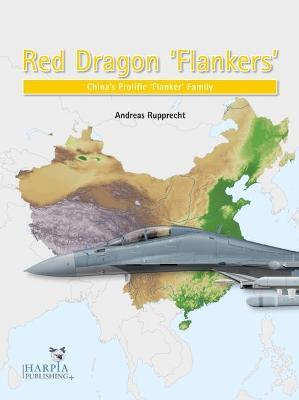
Red Dragon ‘Flankers’. China’s Prolific ‘Flanker’ Family. By Andreas Rupprecht. Published by Harpia Publishing, Wien, Austria, in 2022. ISBN 978-1-95039-410-4.
Reviewed by David Hobbs
Andreas Rupprecht is a German aviation author who has gained a high international reputation for his expert knowledge of Chinese aircraft development. Since 2012 he has written a number of books on the subject for Harpia Publishing and Red Dragon ‘Flankers’ describes the evolution of fighters used by the People’s Liberation Army Air Force, PLAAF, and People’s Liberation Army Navy Air Force, PLANAF, that have used a common airframe based on the Sukhoi Su-27.
The book is printed on high quality paper that does full justice to the numerous coloured photographs and drawings that illustrate it and follows a logical path to describe a family of aircraft that share the Western reporting name ‘Flanker’. It gives detailed descriptions of the variants, their design and construction batches, employment by the various arms of the PLA and their armament from both Russian and Chinese sources. Very little Chinese official material is available that describes Flanker performance and the numbers of aircraft in service but Rupprecht has analysed a wealth of material that is available in the public domain to give well-considered and informative summaries of the sub-types and their development. These give the reader an understanding of the aircraft that cannot easily be gathered from any other readily-accessible source.
The material follows a logical sequence beginning with the original single-seat Su-27SK and two-seat Su-27UBK fighters that were purchased from Russia form the late 1980s and the Shenyang J-11 series aircraft that were developed from them and manufactured in China. It also covers the small batch of Russian-made Su-35s that were procured in 2016. Further chapters describe the procurement of the Su-30MKK and Su-30MK2 from Russia and the development of the Chinese-built Shenyang J-16 series which were built in larger numbers. The Shenyang J-15 Flying Shark carrier-borne fighter and its development, including variants not yet in service, have a complete chapter devoted to them. Every type has its avionics and their capabilities described in detail and the author has drawn on his widespread research to give a good idea of the way in which they would be employed by the PLA in a major conflict. Another chapter is devoted to descriptions of the array of weapons and stores that Chinese air force and navy Flankers can carry. These fall into two distinct categories; weapons imported from Russia for use on the aircraft built in Russia and the Chinese weapons carried by the derivative aircraft built in China. Chapter 5 describes the units which operate the various sub-types and also how aircraft can be identified from photographs taken at various periods by understanding their construction numbers and their system-based side numbers. Lastly there is a ‘family-tree’ which shows how the different variants evolved over time and an appendix which shows coloured side drawings that allow the various sub-types to be recognised and a list of characteristics that help to tell them apart.
The author is not daunted by arguments concerning the legal issues over whether some of the Chinese-built aircraft were illegal copies or not. He tackles the question head-on by discussing arguments that have appeared in press and blog statements and taking a considered view on how much weight can be given to them. Significantly he makes the point that the PLANAF J-15 Flying Shark, although built in China, has two Russian-built AL-31F engines. ‘Even today, all Block 04 J-15s use the same engine’, Rupprecht says, ‘this raises the question of whether there is an as-yet unknown secret agreement to continue delivery of AL-31F engines. Perhaps a different form of remuneration was agreed and accusations of the J-15 being a copy or a clone are only part of the truth. Otherwise, it would have been easy to put a stop to this programme’. He also considers arguments about the J-15’s effectiveness but concludes that, contrary to the Russian Navy’s Su-33 which is coming to the end of its effective life, the J-15 with the PLANAF has good prospects, especially the new variant due to enter service designed to take advantage of the electronic catapult launch systems in the next Chinese carrier.
Overall this is an excellent book that I would place in the essential category for anyone with an interest in contemporary Chinese aircraft in general and especially for those with an interest in the Chinese naval air arm. I recommend it highly.



